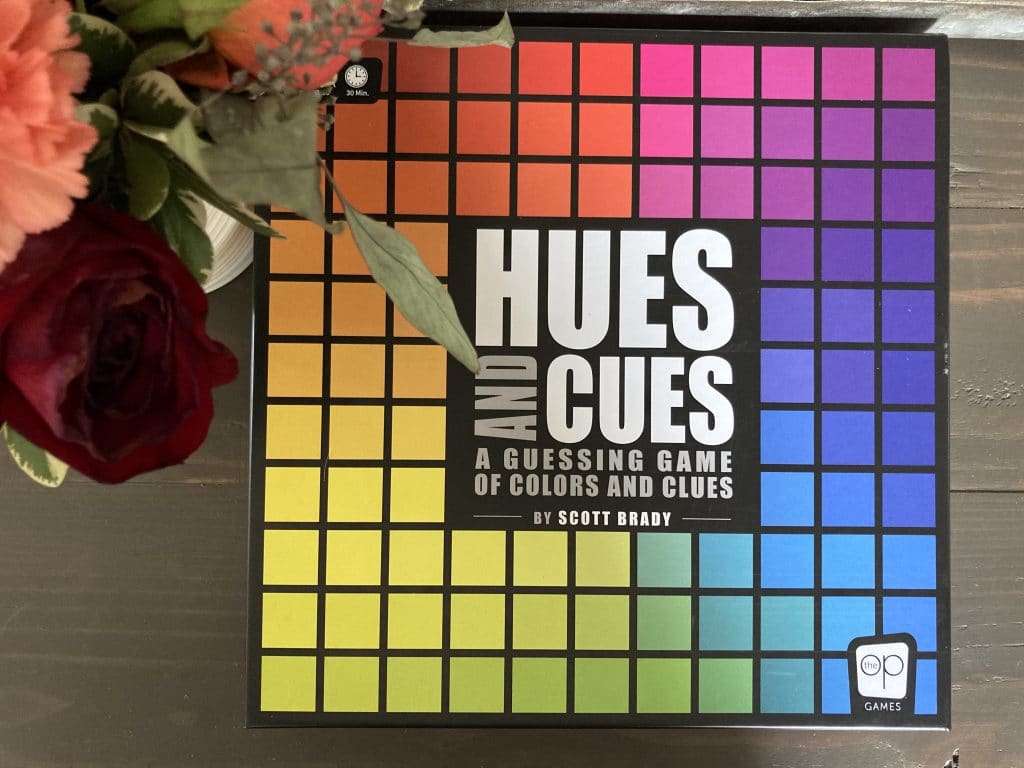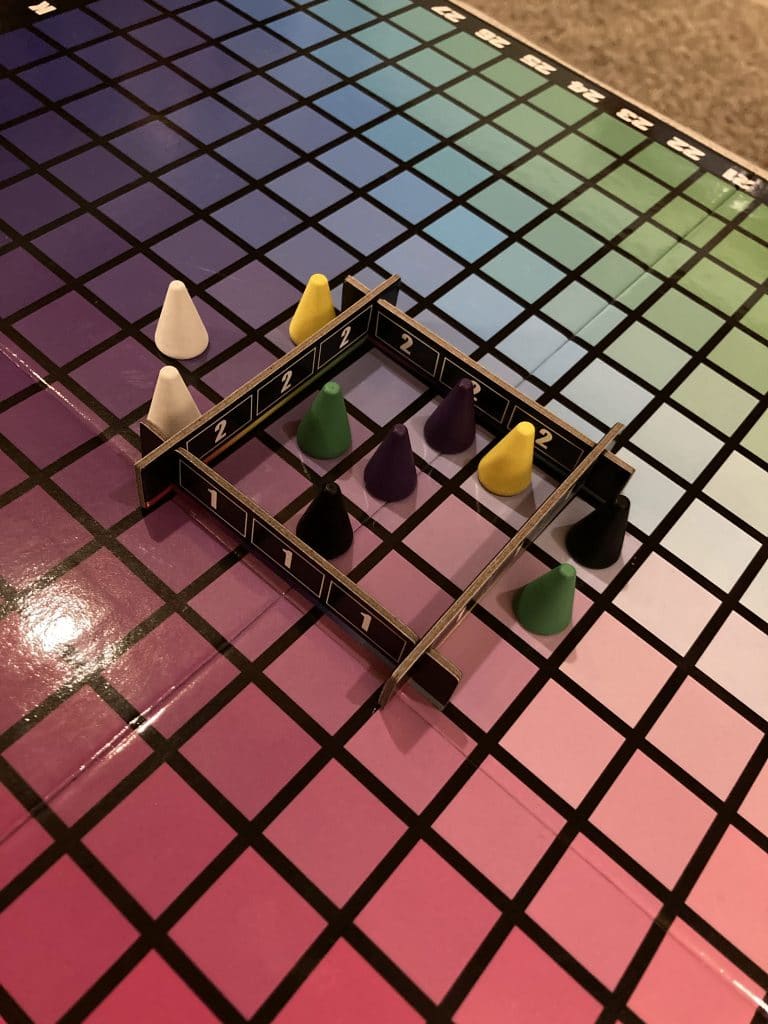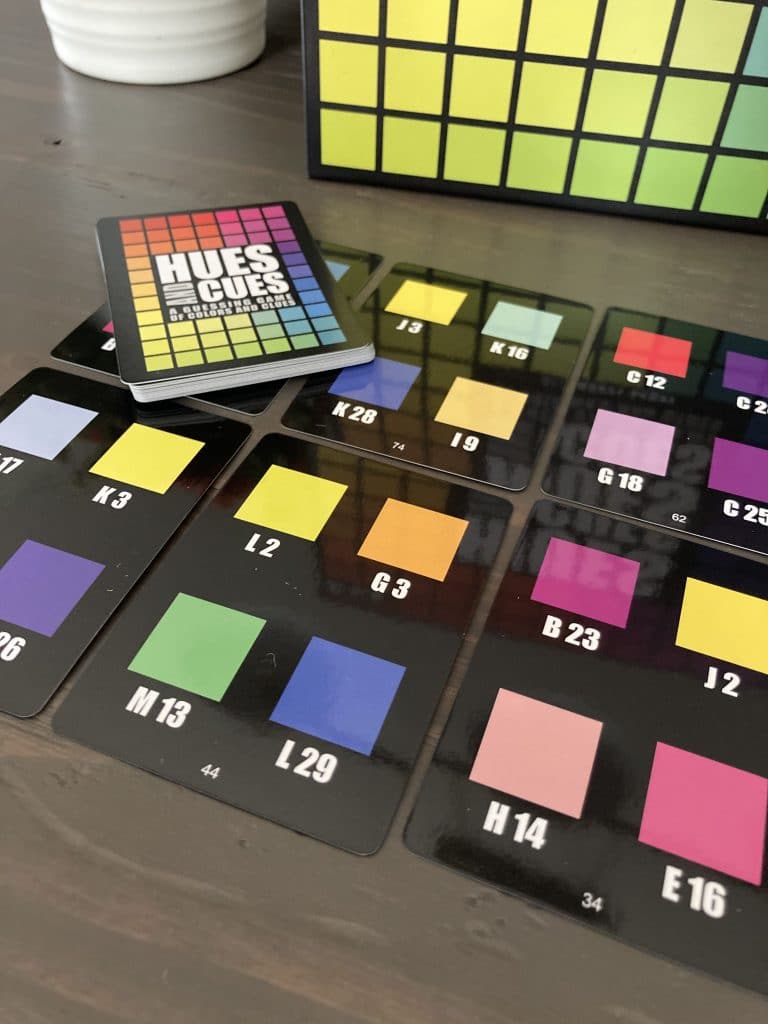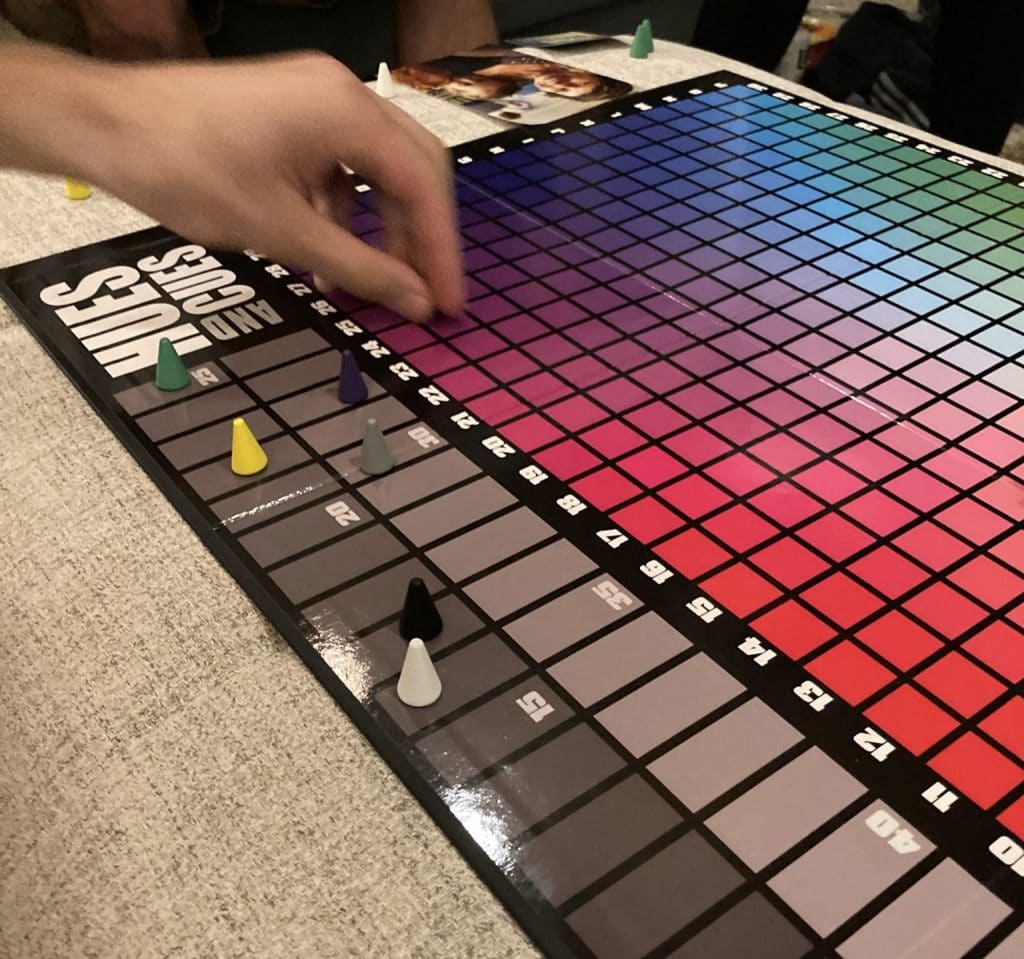When I was younger, I would love going to a dedicated paint store and sneakily take stacks of those color swatch cards. So many beautiful shades of blues, reds, yellows, and everything in between.
If you enjoy describing colors, then The OP’s latest game Hues and Cues is right up your alley. You will be coordinating colors and clues to score points, becoming the ultimate palette master! Let’s find out what we thought about it!

Hues and Cues Gameplay
Hues and Cues plays very simply. One of the players is the first Cue-giver, and will be the one providing cues to the group. I mistakenly said cue more times than I’d like to admit, but the concept is the same.
The Cue-giver draws a card which has four colors on it. Each of the colors corresponds to a color on the gameboard, which is essentially a gigantic grid of beautiful colors. They choose one of the colors and provide a one-word cue about that color.
Using the Cue as their guide, the other players will place their markers on the color square they believe the Cue-giver is describing. After everyone has placed a marker, the Cue-giver can opt to give a second cue, up to two words. If they do, every player gets to place another marker on a new square.
After all of the markers have been placed, the scoring rig descends from the heavens, centered around the color that was initially chosen. Players score based on how close they were to guessing the exact color, and the Cue-giver scores based on how many people were centered around their color.
Good guessers are rewarded, and good cue-givers are also compensated appropriately for their efforts!
Staking Our C.L.A.I.M. on Hues and Cues
![]() COMPONENTS
COMPONENTS
Because of the simplicity of the game, we aren’t dealing with a bunch of components. The board is standard cardboard, wrapped with a vibrant sticker depicting the various colors in the game. It’s glossy, which really helps the colors pop off the board.
The cards have that same glossy finish, making them top-notch as well. Honestly you’d rarely have to shuffle the cards because there are four colors on each, and there are so many of them that you’d never be able to tell if you actually had a duplicate. I also appreciate the savvy design choice to give coordinates to each color and notate those on the cards. It makes finding the colors a breeze.
Each of the player markers is a little, conical piece that resembles the tip of a fresh crayon. Absolutely brilliant. In a game about colors, it’s a perfect decision.
Lastly, the scoring rig is firm cardboard, assembled from four different parts. Again, lots of good player reminders here, as the point scoring is marked right on the inside and outside of the rig. Also I apologize because the official name of the component isn’t ‘scoring rig’, but I’ve become rather attached to the moniker.


![]() LUCK
LUCK
The strategy in Hues and Cues mostly lies in the hands of the Cue-giver. In a lot of games where a single player is a conductor, leader, facilitator, etc, that player rarely has an opportunity to score points on their turn. It’s really nice to see that no matter whether you’re a guesser or a Cue-giver, you have an opportunity to progress down the scoring track.
So let’s talk strategy. After all of the players have made their initial color guess, the Cue-giver can determine whether or not they want to give a second Cue. If a lot of the players are within a single square of the chosen color, it’s in the Cue-giver’s best interest to refrain from a second Cue.
This is because the Cue-giver gets a point for every marker within the interior boundaries of the scoring rig. This is a maximum of nine points. If the maximum number of points a guesser can get is 3 points with a single marker, initiating the scoring after a single cue can limit the points gained by the other players.
So far, there was probably a 25% chance that the Cue-giver wouldn’t give a second Cue. It’s an interesting strategic element that helps players make meaningful choices with their first guess; it might be the only one they get!
![]() AESTHETICS
AESTHETICS
I’ve said it before, but this is a game about color. As such, I expect there to be a multitude of color present. There totally is.

You won’t want to play Hues and Cues under dim lighting conditions, because you’ll experience some eye strain. The colors on the game board are presented in gradient fashion, meaning that colors are next to other, similar colors. The longer you play, the more those colors can blend together, making if difficult to see the differences between them.
Everything is contrasted against a black background, which also helps make those colors explode off the page. For how simple the game and presentation are, I think the design elements coincide very nicely together, creating an appealing overall package.
Of course, I will also note that players with color-blindness will find this game relatively inaccessible. The subtle difference between colors is the core of the gameplay, so having any sort of color blindness will make the game very difficult.
![]() INTEREST
INTEREST
When I first read about the game, my initial thought was that the game wouldn’t have long-lasting legs to stand on. A game about guessing colors? How long before that completely loses its punch?
The game rules suggest playing until everyone has been the Cue-giver twice. Instead of playing to an arbitrary score milestone, I think this is the perfect amount of time to allot to the game. With six players, going two times through the group doesn’t overstay its welcome.
That being said, I don’t think Hues and Cues is a game that you’d breakout every week with the same gaming group. However, you could definitely introduce this to new people and get a great reaction. It’s an easy game that people will understand easily, and new players could honestly jump in mid-round if people want to come and go at, say, a family gathering.
The strength of Hues and Cues lies in its near universal appeal. And if people can give creative cues, all the better!
![]() MOOD
MOOD
While you’re playing the game, you’ll find that some people have drastically different opinions on what color something is. For example, can you remember the exact shade of the Incredible Hulk? What about the hue of Dory’s scales?
We also had numerous situations where the first round of player markers were significantly off from where the Cue-giver intended. There was plenty of ‘what were you thinking’ going on every time that happened. With those more abstract cues, that’s bound to happen.
But when a player hits the nail right on the head and correctly guesses the color exactly, everyone was thrilled! Hues and Cues is a game where you don’t necessarily care about the score as much; it’s all about the game itself.

Hues and Cues: A Designer’s Dream
If you are thinking of repainting some rooms around the house, you can skip the visit to the paint store and pick up Hues and Cues instead. Just hold the game board up to the wall until you decide on the perfect color, and then take it to be color-matched. I’m sure you won’t get any strange looks at all.
Overall, Hues and Cues is a fun, light-hearted game that helps you appreciate the colors that you might see every day. It’s not something that I’ll play frequently, but it will hold a well-deserved place on the shelf for occasions where a simple game is called for.
You can order Hues and Cues directly from The OP, or you can check at your Friendly Local Game Store!
Disclosure: The OP provided Nerds on Earth with a review copy of Hues and Cues in exchange for an honest review.


 COMPONENTS
COMPONENTS